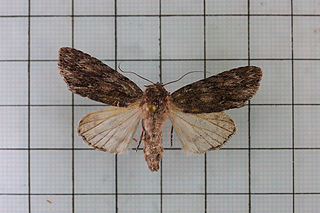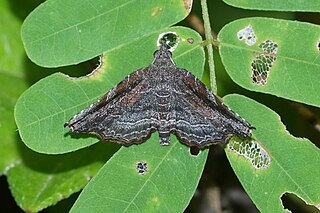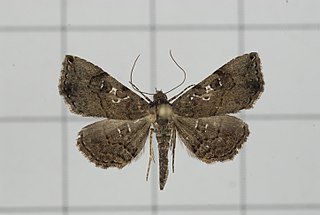
The Noctuidae, commonly known as owlet moths, cutworms or armyworms, are a family of moths. They are considered the most controversial family in the superfamily Noctuoidea because many of the clades are constantly changing, along with the other families of the Noctuoidea. It was considered the largest family in Lepidoptera for a long time, but after regrouping Lymantriinae, Catocalinae and Calpinae within the family Erebidae, the latter holds this title now. Currently, Noctuidae is the second largest family in Noctuoidea, with about 1,089 genera and 11,772 species. This classification is still contingent, as more changes continue to appear between Noctuidae and Erebidae.

Craniophora ligustri, the coronet, is a moth of the family Noctuidae. The species was first described by Michael Denis and Ignaz Schiffermüller in 1775. It is found in Europe, through the Palearctic to Japan.

Craniophora is a genus of moths of the family Noctuidae.
Dysgonia dulcis is a moth of the family Noctuidae first described by Arthur Gardiner Butler in 1878. It is found in Korea, China, Japan, the Russian Far East and Taiwan.

Craniophora pontica is a moth of the family Noctuidae. It is found from the southern Balkans through the Near East and parts of the Middle East to Afghanistan. In the Levant it has been recorded from Lebanon and Israel.
Craniophora melanisans is a moth of the family Noctuidae. It is endemic to the oases of Saudi Arabia, Oman and Israel.

Acronicta albistigma is a moth of the family Noctuidae. It is found in China, Japan, and Taiwan.

Acronicta hercules is a moth of the family Noctuidae. It is found in the Korean Peninsula, Japan, the Russian Far East, China, and Taiwan.

Acronicta digna is a moth of the family Noctuidae. It is found in the Korean Peninsula, Japan, the Russian Far East, China, and Taiwan.

The Erebidae are a family of moths in the superfamily Noctuoidea. The family is among the largest families of moths by species count and contains a wide variety of well-known macromoth groups. The family includes the underwings (Catocala); litter moths (Herminiinae); tiger, lichen, and wasp moths (Arctiinae); tussock moths (Lymantriinae), including the arctic woolly bear moth ; fruit-piercing moths ; micronoctuoid moths (Micronoctuini); snout moths (Hypeninae); and zales, though many of these common names can also refer to moths outside the Erebidae. Some of the erebid moths are called owlets.

Craniophora fujianensis is a moth of the family Noctuidae, named for the Fujian province where it was discovered in 2004. The species is found in Fujian and Hainan Provinces in China, but the nominate subspecies is found only in Fujian, and subspecies C. f. hainanensis is restricted to Hainan.

Craniophora sichuanensis is a moth of the family Noctuidae. It is found in China (Sichuan). The habitat consists of virgin mixed forests.

Craniophora praeclara is a moth of the family Noctuidae. Its distribution includes North Korea, Japan, China, and the Russian Far East.

Caduca albopunctata is a moth of the family Noctuidae first described by Francis Walker in 1857.

Nagadeba indecoralis is a moth of the family Noctuidae first described by Francis Walker in 1865. It is found in Sri Lanka, Java, India, Myanmar, India's Andaman Islands, Japan and Taiwan.

Rhesala imparata is a moth of the family Erebidae first described by Francis Walker in 1865. It is sometimes referred to as an Albizia defoliator. It is found in Sri Lanka, India, Taiwan, Singapore and Borneo.

Callyna monoleuca is a moth of the family Noctuidae first described by Francis Walker in 1858. It is found in Sri Lanka, India, China, Japan, Taiwan, Myanmar, Indonesia, New Guinea and Australia.

Craniophora fasciata is a moth of the family Noctuidae first described by Frederic Moore in 1884. It is found in Sri Lanka, Japan, Korea, Taiwan, Thailand and Australia.

Feliniopsis indistans is a moth of the family Noctuidae first described by Achille Guenée in 1852. It is found in India, Sri Lanka, Hong Kong, Japan and Taiwan.
Sugia stygia is a moth of the family Noctuidae first described by Arthur Gardiner Butler in 1878. It is found in Japan, Korea, India, Sri Lanka, Taiwan and China.















